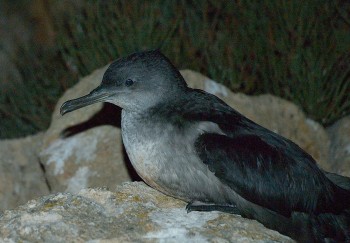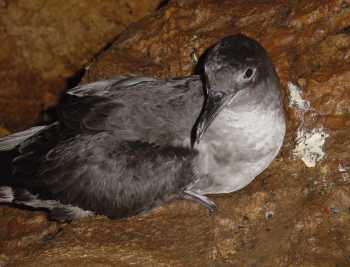The Vulnerable Pink-footed Shearwater Puffinus creatopus, a Chilean breeding endemic species, breeds on Mocha and Juan Fernández Islands off central Chile (click here). The species is a transequatorial migrant reaching western North America including the Gulf of Alaska and southern Bering Sea.
International concern about the species is reflected in its recent listing as Threatened by the Committee on the Status of Endangered Wildlife (COSEWIC) in Canada and as of Common Concern by the Canada/Mexico/U.S. Trilateral Committee. This has triggered several site-specific Conservation Plans for the species. In Chile, the Corporación Nacional Forestal (National Forestry Corporation) developed a National Plan of Action for the Pink-footed Shearwater in 2007.
A workshop was held in Valparaíso in the Instituto de Fomento Pesquero (Fisheries Development Institute) on 15 January. The workshop’s main goal was to assess the status of the Chilean National Plan of Action for the Pink-footed Shearwater and share the state of knowledge for the species by reviewing the main activities implemented for addressing threats both on land and at sea.

Attendants at the one-day workshop in the Instituto de Fomento Pesquero
The workshop was led by Marcelo García (Subsecretaría de Pesca y Acuicultura de Chile) and Jorge Azócar (Instituto de Fomento Pesquero) with the participation of Charif Tala and Sandra Diáz (Ministerio de Medio Ambiente de Chile), Moises Grimber, Javier Meza and Guillermo Reyes (Corporación Nacional Forestal), Peter Hodum, Valentina Colodro and Verónica Lopez (Oikonos), Holly Freifeld (American Bird Conservancy), Erin Hagen (Island Conservation), and Luis Cabezas (BirdLife Albatross Task Force Chile).
The discussions resulted in a schedule of activities which will have the dual purpose of developing the National Plan of Action based on the new scheme of the Chilean institutions and progressing the incorporation of the Pink-footed Shearwater into Annex 1 of the Agreement on the Conservation of Albatrosses and Petrels (click here).
A second meeting is due to be held in April this year at the Instituto de Fomento Pesquero.
With thanks to Jorge Azócar, Chile for information and the photograph.
Selected References:
Commission for Environmental Cooperation 2005. North American Conservation Action Plan: Pink-footed Shearwater. Secretariat of the Commission for Environmental Cooperation. vii + 49 pp.
Committee on the Status of Endangered Wildlife in Canada 2004. COSEWIC Assessment and Status Report on the Pink-footed Shearwater. Ottawa: Committee on the Status of Endangered Wildlife in Canada. vii + 22 pp.
Environment Canada 2008. Recovery strategy for the Short-tailed Albatross (Phoebastria albatrus) and the Pink-footed shearwater (Puffinus creatopus) in Canada. Species at Risk Act Recovery Strategy Series. Ottawa: Environment Canada. vii + 46 pp.
Hinojosa S.A. & Hodum, P.J. 2008. Plan nacional para la conservación de la fardela de vientre blanco Puffinus creatopus Coues, 1864 en Chile. Corporación Nacional Forestal (CONAF) and Comisión Nacional del Medio Ambiente (CONAMA), Chile. 34 pp.
Juan Pablo Seco Pon, ACAP South American News Correspondent, 12 February 2014

 English
English  Français
Français  Español
Español 


